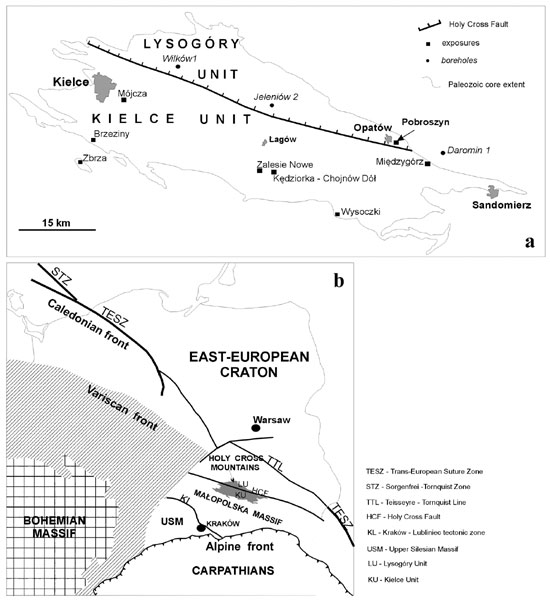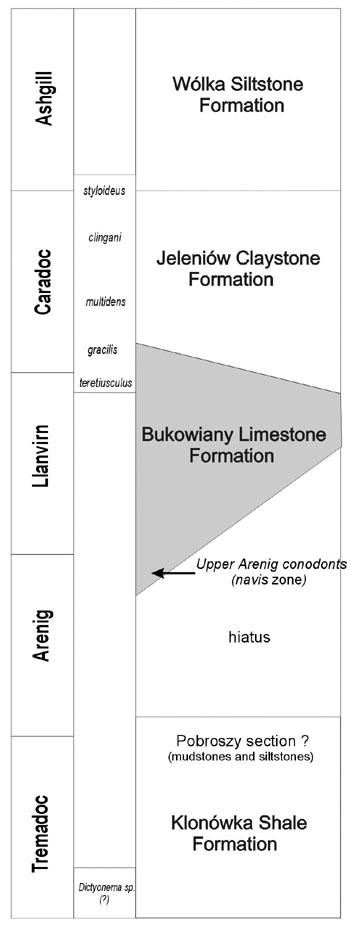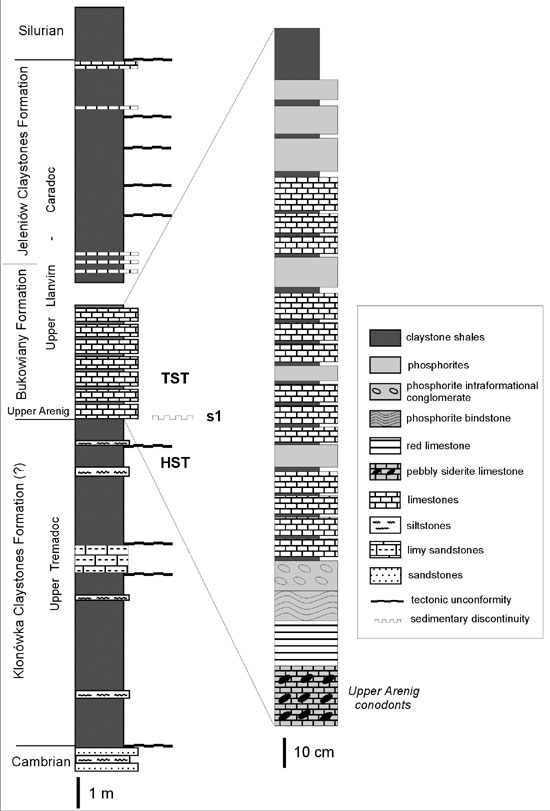
Sedimentary environment of the Ordovician phosphate–bearing sequence in central Poland (Holy Cross Mts.)
Wieslaw Trela1
1 Polish Geological Institute, Holy Cross Mts. Branch. Zgoda 21, 25-953 Kielce. E–mail: trela@pgi.kielce.pl
Key words: Ordovician. Phosphorite. Microbial sediments. Sea-level changes. Upwellings.
Introduction
Geological setting
This report deals with sedimentary environment of the Middle to Upper Ordovician phosphate-bearing sequence in Pobroszyn, located in the Lysogóry Unit, northern part of the Holy Cross Mts. (Figure 1a). The Lysogóry Unit located between East European Craton and the Kielce Unit (northern part of the Malopolska Massif) is regarded to be passive margin of the East European Craton (Dadlez et al., 1994) or a separated terrain (Pozaryski, 1990) with suggested Gondwanian provenance (Valverde-Vaquero et al., 2000). The occurrence of the Ordovician deposits in Pobroszyn was reported for the first time by Samsonowicz (1934) and than they were investigated by Tomczyk (1957), Kowalczewski et al. (1976), Trela et al. (1999, 2001) and Dzik (1999). The Pobroszyn section is a good example of relation between phosphogenesis, microbial activity, relative sea level changes and oceanographic circulation in the Mid- to Late Ordovician.
The phosphate-bearing deposits in the Pobroszyn section belong to the Bukowiany Formation of the Upper Llanvirn and lowermost Caradoc (Figures 2, 3) (Bednarczyk, 1981; Wrona, 2002), notwithstanding Dzik (1999) reported the Upper Arenig conodonts in the lowermost part of the analyzed section. The Bukowiany Formation is up to 4,0 m thick in Pobroszyn and 23 m thick in Jeleniów 2 borehole and is regarded as transgressive system tract associated with tectonically-induced Late Llanvirn (or even Late Arenig?) relative sea level rise (Tomczyk and Turnau-Morawska, 1967; Trela et al., 1999, 2001). There is a stratigraphical gap between the Bukowiany Formation and underlying the Upper Tremadoc/lowermost Arenig mudstone and siltstone of the Klonówka Shale Formation (Figure 2) (Tomczyk and Tumau-Morawska, 1967; Bednarczyk, 1981; Trela et al., 1999, 2001). The abrupt facies change observed between these two units is associated with tectonic activity of the Holy Cross Mts. during the Late Tremadoc to Early Arenig coeval with Ceratopyge global regression (Erdtmann, 1986), which led to emergence of the central and eastern part of the Lysogóry Unit as well as some areas of the Kielce Unit. In central part of the Lysogóry Unit, the Bukowiany Formation is overlain by the Jeleniów Claystone Formation of the Caradoc age (Figure 2), but in Pobroszyn there is a tectonic boundary between these units (Figure 3). The spatial and temporal facies extent in the eastern part of the Lysogóry Unit and biostratigraphy of the Ordovician deposits in Pobroszyn and Daromin 1 indicate that the upper part of the Bukowiany Formation is coeval with lower part of the Jeleniów Claystone Formation (cf. Tomczykowa and Tomczyk, 2000; Trela et al., 2001; Wrona, 2002).
Sedimentological characteristic
The Bukowiany Formation in Pobroszyn section is composed of thin-bedded gray green limestones with dark gray and black phosphorite interbeds, and thin claystone intercalations (Figure 3). The mean P2O5 content in phosphorites from the analyzed section is 20 % wt.

Figure 1. A. Location of the Pobroszyn section in the Lysogóry Unit. B. Location of the Holy Cross Mts. and the Lysogóry Unit on background of the main geotectonic units of Poland (according Dadlez et al., 1994).

Figure 2. Ordovician lithostratigraphy in the Lysogóry Unit.
The basal, 50 cm thick, part of the section is distinctive for its sedimentological record and significance to reconstruction of the sedimentary environment in the Lysogóry Unit. In its lower part gray-green siderite limestone bed occurs (10-15 cm thick) that lays on the Upper Tremadoc/lowermost Arenig mudstones and siltstones (probably Klonówka Shale Formation) (Figure 3). It is striking that the limestone bed is lacking macrofossils but yields conodonts of the Late Arenig (Baltoniodus navis) (Dzik, 1999) and reavils feature of subaerial exposure, e.g., thin layers and lenses of calcite microstalactite, caliche–like surfaces and pendant (radiaxial) calcite cement on some grains (Trela et al., 2001).
The pebbly limestone is capped by 20 cm thick bed of red limestones with low-angle cross bedding that is followed by a phosphorite bindstone bed up to 10 cm thick (Figure 3). Thin (0.5 cm) phosphatic microbial mats and washout traces occur in the lower part of the latter bed, whereas in its upper part numerous erosional surfaces appear that are cut in phosphatic mudstones and coated with iron hydroxides appear.
The phosphorite bindstone is capped by intraformational conglomerate bed, up to 10 cm thick composed of poorly rounded and sorted phosphorite and rare limestones intraclasts (0.3 to 7.0 cm) (Figure 3). The limestone clasts contain crinoids and dispersed, deformed chips-like phosphorite mudstones.
The upper part of the section is composed of 3.5 m thick sequence of thin-bedded green-gray lime mudstones and claystones interbedded with phosphorites (5-15 cm thick) (Figure 3). It contains numerous spherical and discoidal phosphorite nodules; the first one is about 0.5–4.0 cm in diameter whereas the longer axes of discoidal nodules vary from 2 to 10 cm. The lime mudstones show horizontal lamination and small–scale cross bedding as well as dispersed small limestone and phosphorite intraclasts (0.5 cm up to 2.0 cm). The phosphorites from the upper part of the section are developed as massive and slumped phosphatic mudstones to wackestones or pristine phosphatic laminae and lenses. Apart from the described lithotypes there are also beds of mixed composition that consist of plastically deformed phosphorites and limestones.
Sedimentary environment
During the Late Arenig in central part of the Lysogóry Unit, very shallow water environment with periods of subaerial exposure was established (pebbly siderite limestone) due to tectonically–induced sea level rise (Trela et al., 2001). The sea encountered peneplained, low relief land area that subjected to emergance since the earliest Arenig. Considering the presence of the Late Arenig conodonts in the pebbly limestone (Dzik, 1999) and the Llanvirn to Caradoc chitinozoans above (Wrona, 2002) it seems that the basal limestone records an extreme sediment condensation.
A further rise of the relative sea level during the Late Llanvirn resulted in increase of the water depth (sublittoral zone) and reduction of the terrigenous input, what was crucial for phosphogenesis (cf., Riggs, 1986; Glenn et al., 1994). Sediment subjected to storm–induced reworking events that favoured the condensetion. Taking into consideration the presence of the limestone intraclasts within the phosphorite conglomerate, it seems possible that nearby might have existed raised energy shoals colonized by echinoderms and other organisms might have existed. Between these shoals, in the sheltered, quiet–water environment the phosphatic mud was deposited that also subjected to reworking as is evidenced by chips–like phosphorite mudstones within the limestone intraclasts.

Figure 3. Ordovician deposits in the Pobroszyn section.
The occurrence of the phosphatic microbial mats in Pobroszyn suggests an important and efficient role of the microbial communities in the enrichment of the phosphorous within the pore waters due to their ability for uptaking and releasing phosphorous from an aqueous medium (cf., Krajewski et al., 1994; Glenn et al., 1994). The basic prerequisite in phosphogenesis is a supply of phosphorous from an external environment. The enlarged supply of phosphorous may be attributed with inflow of nutrient–rich upwelling waters (cf. Parrish, 1982; Riggs, 1986; Glenn et al., 1994). Considering the close location of the Lysogóry Unit and Kielce Unit during the Mid– to Late Ordovician it seems possible that phosphorites from Pobroszyn may be associated with the upwelling conditions that phosphatized the Middle and Upper Ordovician (upper serrus to tvaerensis/superbus zones) limestones in Kielce Unit (Trela 2000, 2002).
The upper part of the phosphate-bearing section in Pobroszyn is probably related to the maximum flooding of the latest Llanvirn/Caradoc relative sea level rise. Deposition took place in low-energy environment where calcareous mud was accumulated beneath the storm wave base with periods of sediment erosion and redeposition by storm-induced currents or gravity flows. A general lithological development and sedimentological record of the upper part of the Pobroszyn section (and Bukowiany Formation) resembles carbonate slope deposits.
Acknowledgements
This work is a contribution to Paleozoic Accretion of Poland (PCZ 07–21), financed by the State Committee for Scientific Research and the Ministry of Environment.
References
Bednarczyk, W. 1981. Stratygrafia ordowiku Gór Swietokrzyskich. W: Przewodnik 53 Zjazdu Polskiego Towarzystwa Geologicznego – Kielce: 35–41.
Dadlez, R., Kowalczewski, Z. and Znosko, J. 1994. Niektóre kluczowe problemy przedpermskiej tektoniki Polski. Geological Quarterly, 38: 169–190.
Dzik, J. 1999. The Ordovician in the Holy Cross Mountains. In: J. Dzik, U Linnemann and T. Heuse (Ed.). International Symposium on the Ordovician System, ISOS Prague 1999, Pre – Conference Field trip, Excursion guide Poland and Germany: 3–7.
Erdtmann, B.D. 1986. Early Ordovician eustatic cycles and their bearing on punctuations in early nemaphorid (planctonic) graptolite evolution. In: Walliser, O., (Ed.) Global Bio–Events. Lecture Notes in Earth Sciences, 8: 139–152. Springer.
Glenn, C. R., Föllimi, K. B., Riggs, S. R., Baturin, G. N., Grimm, K. A., Trappe, J., Abed, A. M., Galli–Olivier, C., Garrison, R. E., Ilyin, A. V., Jehl, C., Rohrlich, V, Sadaqah, R. M., Schidlowski, M., Sheldon, R. E. and Siegmund, H., 1994. Phosphorus and phosphorites. Sedimentology and environments of formation: Ecologae Geologica Halvetica, 87: 747–788.
Kowalczewski, Z., Lisik, R. and Chlebowski, R. 1976. Nowe dane o budowie geologicznej rejonu Opatowa. Biuletyn Instytutu Geologicznego, 269: 167–207.
Krajewski, K. P., Van Cappellen, P., Trichet, J. Kuhn, O., Lucas, J., Martin–Algarra, A., Prévôt, L., Tewari, V. C., Gaspar, L., Knight, R. I. and Lamboy, M. 1994. Biological processes and apatite Formation in sedimentary environments. Ecologae Geologica Halvetica, 87: 701–745.
Parrish, J.T. 1982. Upwelling and petroleum source beds, with reference to Paleozoic. Am. Ass. Petrol. Geol., Bull., 66: 750–774.
Pozaryski, W. 1990. The Middle Europe Caledonides – wrenching orogen composed of terranes (English summary). Przeglad Geologiczny, 38 (1): 1–9.
Riggs, S.R. 1986. Proterozoic and Cambrian phosphorites – specialist studies: phosphogenesis and its relationship to exploration for Proterozoic and Cambrian phosphorites. In: Cook, P.J. and Shergold J.H., (Eds.), Phosphate Deposits of the World, vol. 1. Cambridge University Perss, Cambridge: 352–368.
Samsonowicz, J. 1934. Objasnienie arkusza Opatów, pp 117. Panstwowy Instytut Geologiczny, Warszawa.
Tomczyk, H. 1957. O facji graptolitowej karadoku Gór Swietokrzyskich. Kwartalnik Geologiczny, 1, 462–479.
Tomczyk, H. and Turnau–Morawska, M. 1967. Zagadnienia stratygrafii i sedymentacji ordowiku Lysogór w nawiazaniu do niektórych profilów obszaru poludniowego. Acta Geologica Polonica, 17: 1–46.
Tomczykowa, E., and Tomczyk, H. 2000. Starszy paleozoik z otworu Daromin IG 1 – potwierdzenie budowy terranowej bloku lysogórskiego i malopolskiego (Góry Swietokrzyskie). Biuletyn Panstwowego Instytutu Geologicznego, 393: 167–203.
Trela, W. 2000. Isotope (18O and 13C) from the Upper Ordovician limestones in Mójcza section (Holy Cross Mts., Central Poland). Przeglad Geologiczny, 48: 736–740 (English summary).
Trela, W. 2002. Rozwój sedymentacji weglanowej w srodkowym i póznym ordowiku, w regionie kieleckim Gór Swietokrzyskich. Posiedzenia Naukowe PIG, 58 (10): 104–107.
Trela, W., Szczepanik, Z. and Salwa, S. 1999. Pobroszyn: excursion I, stop 3. In: Dzik, J., Linnemann, U., and Heuse, T., (Eds.) International Symposium on the Ordovician System, ISOS Prague 1999, Pre – Conference Fieldtrip, Excursion guide Poland and Germany, 14–17.
Trela, W., Szczepanik, Z. and Salwa, S. 2001. The Ordovician rocks of Pobroszyn in Lysogóry region of the Holy Cross Mountains, Poland. Geological Quarterly, 45: 29–40.
Valverde–Vaquero, P., Dörr, Z., Belka, Z., Franke, W., Wiszniewska, J. and Schastok, J. 2000. U–Pb single–grain dating of detrital zircon in the Cambrian of central Poland: implications for Gondwana versus Baltica provenance studies. Earth and Planetary Science Letters, 184: 225–240.
Wrona, R. 2002. Ordowickie Chitinozoa jako wskaznik pochodzenia paleogeograficznego terranu lysogórskiego. Przeglad Geologiczny, 50: 1225.
Received: February 15, 2003
Accepted: June 15, 2003